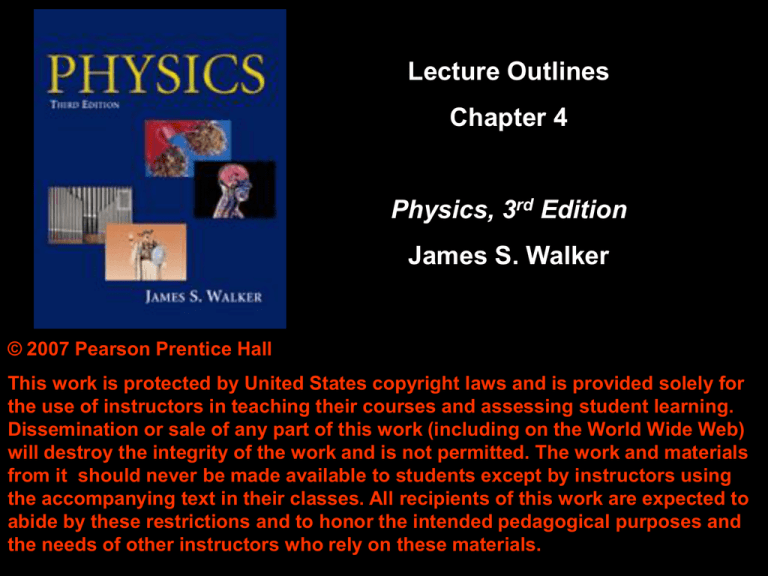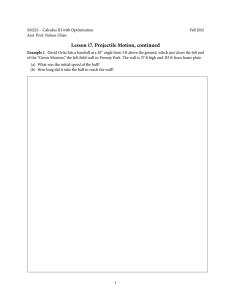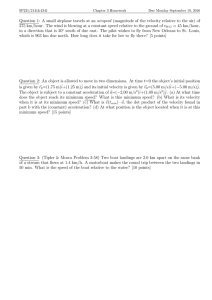
Lecture Outlines
Chapter 4
Physics, 3rd Edition
James S. Walker
© 2007 Pearson Prentice Hall
This work is protected by United States copyright laws and is provided solely for
the use of instructors in teaching their courses and assessing student learning.
Dissemination or sale of any part of this work (including on the World Wide Web)
will destroy the integrity of the work and is not permitted. The work and materials
from it should never be made available to students except by instructors using
the accompanying text in their classes. All recipients of this work are expected to
abide by these restrictions and to honor the intended pedagogical purposes and
the needs of other instructors who rely on these materials.
Chapter 4
Two-Dimensional
Kinematics
Units of Chapter 4
• Motion in Two Dimensions
• Projectile Motion: Basic Equations
• Zero Launch Angle
• General Launch Angle
• Projectile Motion: Key Characteristics
4-1 Motion in Two Dimensions
If velocity is constant, motion is along a
straight line:
4-1 Motion in Two Dimensions
Motion in the x- and y-directions should be
solved separately:
4-2 Projectile Motion: Basic Equations
Assumptions:
• ignore air resistance
• g = 9.81 m/s2, downward
• ignore Earth’s rotation
If y-axis points upward, acceleration in
x-direction is zero and acceleration in
y-direction is -9.81 m/s2
4-2 Projectile Motion: Basic Equations
The acceleration is independent of the direction
of the velocity:
4-2 Projectile Motion: Basic Equations
These, then, are the basic equations of
projectile motion:
4-3 Zero Launch Angle
Launch angle: direction of initial velocity with
respect to horizontal
4-3 Zero Launch Angle
In this case, the initial velocity in the y-direction
is zero. Here are the equations of motion, with
x0 = 0 and y0 = h:
4-3 Zero Launch Angle
This is the trajectory of a projectile
launched horizontally:
4-3 Zero Launch Angle
Eliminating t and solving for y as a function
of x:
This has the form y = a + bx2, which is the
equation of a parabola.
The landing point can be found by setting
y = 0 and solving for x:
4-4 General Launch Angle
In general, v0x = v0 cos θ and v0y = v0 sin θ
This gives the equations of motion:
4-4 General Launch Angle
Snapshots of a trajectory; red dots
are at t = 1 s, t = 2 s, and t = 3 s
4-5 Projectile Motion: Key Characteristics
Range: the horizontal distance a projectile
travels
If the initial and final elevation are the same:
4-5 Projectile Motion: Key Characteristics
The range is a maximum when θ = 45°:
4-5 Projectile Motion: Key Characteristics
Symmetry in projectile motion:
Summary of Chapter 4
• Components of motion in the x- and ydirections can be treated independently
• In projectile motion, the acceleration is –g
• If the launch angle is zero, the initial velocity
has only an x-component
• The path followed by a projectile is a
parabola
• The range is the horizontal distance the
projectile travels






